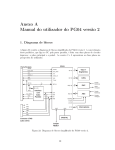Download USER'S GUIDE BACI Pascal Compiler and
Transcript
USER’S GUIDE
BACI Pascal Compiler and
Concurrent PCODE Interpreter
Bill Bynum/Tracy Camp
College of William and Mary/Colorado School of Mines
July 14, 2003
BACI Pascal Compiler User’s Guide
1
Contents
1
Introduction
2
2
Pascal Compiler Syntax
2
3
Concurrency Constructs
3.1 COBEGIN—COEND . . . . . . . . . . . . . . . . . . . . . . . .
3.2 Semaphores . . . . . . . . . . . . . . . . . . . . . . . . . . . . .
3.2.1 Initializing a Semaphore . . . . . . . . . . . . . . . . . .
3.2.2 P (or WAIT) and V (or SIGNAL) Procedures . . . . . . . . .
3.2.3 Examples of Semaphore Usage . . . . . . . . . . . . . .
3.3 Monitors . . . . . . . . . . . . . . . . . . . . . . . . . . . . . . .
3.3.1 Condition Variables . . . . . . . . . . . . . . . . . . . . .
3.3.2 WAITC and SIGNALC Procedures . . . . . . . . . . . . . .
3.3.3 Immediate Resumption Requirement . . . . . . . . . . .
3.3.4 An Example of a Monitor . . . . . . . . . . . . . . . . .
3.4 Other Concurrency Constructs . . . . . . . . . . . . . . . . . . .
3.4.1 ATOMIC Keyword . . . . . . . . . . . . . . . . . . . . . .
3.4.2 PROCEDURE suspend; . . . . . . . . . . . . . . . . . . .
3.4.3 PROCEDURE revive( process number : INTEGER); .
3.4.4 FUNCTION which proc : INTEGER; . . . . . . . . . .
3.4.5 FUNCTION random( range : INTEGER ): INTEGER;
4
.
.
.
.
.
.
.
.
.
.
.
.
.
.
.
.
.
.
.
.
.
.
.
.
.
.
.
.
.
.
.
.
.
.
.
.
.
.
.
.
.
.
.
.
.
.
.
.
.
.
.
.
.
.
.
.
.
.
.
.
.
.
.
.
.
.
.
.
.
.
.
.
.
.
.
.
.
.
.
.
.
.
.
.
.
.
.
.
.
.
.
.
.
.
.
.
.
.
.
.
.
.
.
.
.
.
.
.
.
.
.
.
Built-in String Handling Functions
4.1 PROCEDURE stringCopy(dest : STRING; src : STRING); . . . . . . .
4.2 PROCEDURE stringConcat(dest : STRING; src : STRING); . . . . . .
4.3 FUNCTION stringCompare(x : STRING; y : STRING): INTEGER; . . .
4.4 FUNCTION stringLength(x : STRING): INTEGER; . . . . . . . . . . . . .
4.5 FUNCTION sscanf(x : STRING; fmt : RAWSTRING ; ...): INTEGER;
4.6 PROCEDURE sprintf(x : STRING; x, fmt : RAWSTRING,...); . . . .
.
.
.
.
.
.
.
.
.
.
.
.
.
.
.
.
.
.
.
.
.
.
.
.
.
.
.
.
.
.
.
.
.
.
.
.
.
.
.
.
.
.
.
.
.
.
.
.
.
.
.
.
.
.
.
.
.
.
.
.
.
.
.
.
.
.
.
.
.
.
.
.
.
.
.
.
.
.
.
.
.
.
.
.
.
.
.
.
.
.
.
.
.
.
.
.
.
.
.
.
.
.
.
.
.
.
.
.
.
.
.
.
.
.
.
.
.
.
.
.
.
.
.
.
.
.
.
.
.
.
.
.
.
.
.
.
.
.
.
.
.
.
.
.
.
.
.
.
4
4
4
4
5
6
7
7
7
8
8
8
9
9
9
9
9
.
.
.
.
.
.
10
10
10
10
10
10
11
5
Using the BACI Pascal Compiler and PCODE Interpreter
11
6
Sample program and output
12
BACI Pascal Compiler User’s Guide
2
1 Introduction
The purpose of this document is to provide a brief description of the BACI Pascal Compiler and Concurrent PCODE Interpreter programs and a description of how to use them. The compiler first compiles the
user’s program into an intermediate object code called PCODE, which the interpreter then executes. The
Pascal compiler supports binary and counting semaphores and Hoare monitors. The interpreter simulates
concurrent process execution.
Programs of the BACI System
program
bacc
bapas
bainterp
function
BACI C−− to PCODE Compiler
BACI Pascal to PCODE Compiler
command-line PCODE Interpreter
bagui
Graphical user interface to the
PCODE Interpreter (UNIX systems only)
PCODE de-compiler
PCODE archiver
PCODE linker
badis
baar
bald
described in
cmimi.ps
this guide (guidepas.ps)
cmimi.ps, guidepas.ps
disasm.ps
guiguide.ps
disasm.ps
sepcomp.ps
sepcomp.ps
The compiler and interpreter originally were procedures in a program written by M. Ben-Ari, based
on the original Pascal compiler by Niklaus Wirth. The program source was included as an appendix in
Ben-Ari’s book, “Principles of Concurrent Programming”. The original version of the BACI compiler and
interpreter was created from that source code. Eventually, the compiler and interpreter were split into two
separate programs, and a C−− compiler was developed to compile source programs written in a restricted
dialect of C++ into PCODE object code executable by the interpreter.
The syntax for the Pascal compiler is explained below. This guide is applicable only to the BACI Pascal
compiler and not to the BACI C−− compiler. Users interested in the C−− compiler should consult its user
guide (see the file cmimi.ps).
2 Pascal Compiler Syntax
1. Comments can be delimited with (* and *) or { and }, but the two styles cannot be mixed. C++
comments (beginning with //) are also accepted.
2. There are no files other than input and output. The program header must have the form:
PROGRAM program_name;
READ, READLN, and EOLN (all without a file parameter) behave as in standard Pascal. WRITE and
WRITELN, also used without a file parameter, do not accept width specifiers for the output fields.
3. The only simple Pascal types are INTEGER, BOOLEAN, and CHAR. There are also other types related to
the control of concurrency; these will be discussed below.
4. A STRING type is supported. To declare a string, the length of the string must be specified. The
following declaration defines a string of length 20:
VAR
string_name
:
STRING[20];
BACI Pascal Compiler User’s Guide
3
The length specifier should be the number of characters that the string should have and should not
include space for the termination byte. The compiler takes care of reserving space for the termination
byte. The length specifier must be either a literal constant or a program constant.
The STRING keyword is used in the declaration of a procedure or function for declaring a parameter
of type STRING:
PROCEDURE proc(formal parm :
STRING);
This declaration asserts that formal parm is of type STRING[n], for some positive value of n. Parameters of type STRING are passed by reference. No check for string overrun is performed.
5. Arrays of any valid type are supported. Array declaration follows the usual Pascal syntax:
mytype = ARRAY[ LB..UB ] OF valid_type;
6. There are no subrange types and no RECORD types.
7. Constants of simple types are supported.
8. In the declaration of variables of INTEGER and CHAR types, initializers are supported. The value of the
initializer must be a literal or program constant:
CONST
m =
VAR
j :
k :
c :
5;
INTEGER := m;
INTEGER := 3;
CHAR := ’a’;
9. Procedures and functions are supported with both VAR and non-VAR parameters. Standard scope rules
apply. Recursion is supported.
10. The executable statements are IF-THEN-ELSE, FOR, REPEAT-UNTIL, and WHILE-DO. Statement bracketing with BEGIN-END is standard.
11. File inclusion, using the standard C/C++ syntax, is supported:
#INCLUDE < ... >
#INCLUDE " ... "
Both styles of include statement have the same semantics, because there is no “system” include
directory.
12. The EXTERNAL keyword for defining external variables is supported, but its usage varies from that of
Niklaus Wirth’s “standard” Pascal. In BACI Pascal, the EXTERNAL keyword precedes the definition of
the external object, whereas in Wirth’s Pascal, the keyword trails the definition of the object.
Any an external variable can be of any valid BACI Pascal type. Initializers cannot be used with
external variables. The EXTERNAL keyword can only occur at the global (“outer”) level, before the
PROGRAM keyword has appeared, if the source file contains a main program block.
Typical examples:
BACI Pascal Compiler User’s Guide
//
//
4
EXTERNAL VAR
i : INTEGER;
a : ARRAY [1..20] OF CHAR:
b : STRING[30];
Initializers are not allowed ----> i : INTEGER := 30;
(initialization, if present, must occur where i is defined)
EXTERNAL func(k : INTEGER) : INTEGER;
EXTERNAL MONITOR monSemaphore;
// see Section 3. Only externally
PROCEDURE monP();
// visible details of the monitor
PROCEDURE monV();
// need be given here
END; // monSemaphore
The -c option must be used with bapas to compile source files that contain external references.
See the BACI System Separate Compilation Guide for more information about the use of external
variables.
3 Concurrency Constructs
3.1
COBEGIN—COEND
A process in BenAri Concurrent Pascal is a PROCEDURE. In the BACI system, the term “concurrent process”
is synonymous with the term “concurrent thread.” A list of processes to be run concurrently is enclosed in a
COBEGIN—COEND block. Such blocks cannot be nested and must appear in the main program.
COBEGIN
proc1(...); proc2(...); ... ; procN(...);
COEND;
The PCODE statements belonging to the listed procedures are interleaved by the interpreter in an arbitrary, ‘random’ order, so that multiple executions of the same program containing a COBEGIN—COEND
block can appear to be non-deterministic. The main program is suspended until all of the processes in the
COBEGIN—COEND block terminate, at which time execution of the main program resumes at the statement
following the COEND statement.
3.2
Semaphores
The interpreter has a predeclared SEMAPHORE type. That is, a SEMAPHORE in BACI Concurrent Pascal is a
non-negative-valued INTEGER variable (see definition below) that can be accessed only in restricted ways.
The binary semaphore, one that only assumes the values 0 and 1, is supported by the BINARYSEM subtype of
the SEMAPHORE type. During compilation and execution, the compiler and interpreter enforce the restrictions
that a BINARYSEM variable can only have the values 0 or 1 and that a SEMAPHORE variable can only be nonnegative.
3.2.1
Initializing a Semaphore
Assignment to a SEMAPHORE or BINARYSEM variable is allowed only when the variable is declared. For
example, both the following declarations are valid:
VAR
s
b
The built-in procedure
: SEMAPHORE := 17;
: BINARYSEM := 0;
BACI Pascal Compiler User’s Guide
5
INITIALSEM( semaphore, integer_expression );
is the only method available for initializing a semaphore of either type at runtime. In the call, the parameter
integer_expression can be any expression that evaluates to an integer value is valid for the semaphore
(non-negative for a SEMAPHORE type, or 0 or 1 for a BINARYSEM type). For example, the following two
INITIALSEM calls show an alternative way to initialize the two semaphores declared above:
INITIALSEM( s, 17);
INITIALSEM( b, 0);
3.2.2
P (or WAIT) and V (or SIGNAL) Procedures
The P procedure (or synonymously, WAIT) and the V procedure (or synonymously, SIGNAL) are used by
concurrently executing processes to synchronize their actions. These procedure provide the user with the
only way to change a semaphore’s value.
The prototypes of the two procedures is as follows:
PROCEDURE P(VAR s : SEMAPHORE);
or equivalently,
PROCEDURE WAIT(VAR s : SEMAPHORE);
and
PROCEDURE V(VAR s : SEMAPHORE);
or equivalently,
PROCEDURE SIGNAL(VAR s : SEMAPHORE);
The SEMAPHORE argument of each procedure is shown as a VAR parameter, because the procedure modifies the value of the SEMAPHORE.
The semantics of the P and V procedure calls are as follows:
P(sem);
If sem > 0, then decrement sem by 1 and return, allowing P’s caller to continue.
If sem = 0, then put P’s caller to sleep. These actions are atomic, in that they are non-interruptible and
execute from start to finish.
V(sem);
If sem = 0 and one or more processes are sleeping on sem, then awake one of these processes. If
no processes are waiting on sem, then increment sem by one. In any event, V’s caller is allowed to
continue. These actions are atomic, in that they are non-interruptible and execute from start to finish.
Some implementations of V require that processes waiting on a semaphore be awakened in FIFO order
(queuing semaphores), but the BACI Interpreter conforms to Dijkstra’s original proposal by randomly
choosing which process to re-awaken when a signal arrives.
BACI Pascal Compiler User’s Guide
3.2.3
6
Examples of Semaphore Usage
To help to explain semaphore usage, we offer the following brief example:
BACI System: BenAri Pascal PCODE Compiler, 09:22
2 May 2002
Source file: semexample.pm Thu May 9 09:47:54 2002
line pc
1
0 PROGRAM semexample;
2
0
// example of C-- semaphore usage
3
0 VAR
4
0
count
: SEMAPHORE;
// a "general" semaphore
5
0
output
: BINARYSEM;
// a binary (0 or 1) semaphore for unscrambling output
6
0
7
0 PROCEDURE increment;
8
0 BEGIN
9
0
P(output);
// obtain exclusive access to standard output
10
2
WRITELN(’before V(count) value of count is ’,count);
11
6
V(output);
12
8
V(count);
// increment the semaphore
13
10 END; // increment
14
11
15
11 PROCEDURE decrement;
16
11 BEGIN
17
11
P(output);
// obtain exclusive access to standard output
18
13
WRITELN(’before P(count) value of count is ’,count);
19
17
V(output);
20
19
P(count);
// decrement the semaphore (or stop -- see manual text)
21
21 END; // decrement
22
22
23
22 BEGIN // semexample
24
23
INITIALSEM(count,0);
25
26
INITIALSEM(output,1);
26
29
COBEGIN
27
30
decrement; increment;
28
34
COEND;
29
35 END. // semexample
The program uses two semaphores. One semaphore, count, is of SEMAPHORE type, which indicates
to the BACI system that the semaphore will be allowed to have any non-negative value. The two concurrent procedures, increment and decrement, “signal” each other through the count semaphore. The
other semaphore, output, is of BINARYSEM type, which indicates to the BACI system that the semaphore
should always have the value zero or one; any other value causes a run-time exception. This semaphore is
used to keep the output from the two concurrently executing procedures, increment and decrement from
intermingling.
We produced the above compiler listing with the command
prompt% bapas semexample
Pcode and tables are stored in semexample.pco
Compilation listing is stored in semexample.lst
The semexample.pco file can then be executed with the BACI PCODE interpreter:
prompt% bainterp semexample
Source file: semexample.pm Thu May
Executing PCODE ...
before V(count) value of count is 0
before P(count) value of count is 1
9 09:47:54 2002
This execution of the PCODE file is one of the three possible outputs that the program can produce. The
other two possible program outputs are
BACI Pascal Compiler User’s Guide
7
Source file: semexample.pm Thu May
Executing PCODE ...
before P(count) value of count is 0
before V(count) value of count is 0
prompt% bainterp semexample
Source file: semexample.pm Thu May
Executing PCODE ...
before V(count) value of count is 0
before P(count) value of count is 0
9 09:47:54 2002
9 09:47:54 2002
An interested reader might find it instructive to supply explanations for ways in which these three program outputs are generated and to show that these three outputs are the only outputs possible.
3.3
Monitors
The monitor concept, as proposed by Hoare, is supported with some restrictions. A MONITOR is a Pascal
block, like a block defined by a procedure or function, with some additional properties. All procedures and
functions in the monitor block are visible (that is, callable entry procedures) from the outside of the block,
but the monitor variables are not accessible outside of the block and can only be accessed by the procedures
and functions of the monitor. In BACI Concurrent Pascal, a monitor can be declared only at the outermost,
global level. Monitors can not be nested. The code between the BEGIN—END at the end of the monitor block
is run when the main program is started. Use this block to initialize the values of the monitor variables.
Only one procedure or function of the monitor block can execute at any given time. This feature makes
it possible to use monitors to implement mutual exclusion. Use of monitors to control concurrency is
advantageous because all of the code controlling concurrency is located in the monitor and not distributed
widely across callers, as is the case when semaphores are used.
Three constructs are used by the procedures and functions of a monitor to control concurrency: CONDITION
variables, WAITC (wait on a condition), and SIGNALC (signal a condition).
3.3.1
Condition Variables
A CONDITION variable can only be defined in a monitor, and thus, can only be accessed by the processes
of the monitor. A CONDITION variable never actually has a value; it is somewhere to wait or something to
signal. A monitor process can wait for a CONDITION to hold or signal that a given CONDITION now holds
through the WAITC and SIGNALC calls.
3.3.2
WAITC and SIGNALC Procedures
WAITC and SIGNALC calls have the following syntax and semantics:
PROCEDURE WAITC(cond :
CONDITION; prio :
INTEGER);
The monitor process (and hence, also the outside process calling the monitor process) is blocked and
assigned the priority prio for being re-awakened (see SIGNALC below). Note that this blocking action
allows some other monitor process to execute, if one is ready.
PROCEDURE WAITC(cond :
CONDITION);
This call has the same semantics as the WAITC above, but the wait is assigned a default priority of 10.
PROCEDURE SIGNALC(cond :
CONDITION);
Wake some process waiting on condition cond with the smallest (highest) priority; otherwise, do
nothing. Note that this is quite unlike the semaphore (V or SIGNAL), because SIGNALC is a no-op if no
one is waiting, whereas V(sem) increments sem if no one is waiting, thus “remembering” the action
when future P(sem)’s occur.
BACI Pascal Compiler User’s Guide
8
The priority scheme can be used to implement a FIFO discipline in re-awakening waiters. If each
MONITOR process increments a monitor variable associated with the current priority assigned to a condition,
then successive SIGNALC’s to the condition will awaken the sleeping processes in FIFO order.
The compiler provides a BOOLEAN-valued function EMPTY(cond) that returns TRUE if there are no processes waiting in the queue of the condition cond and FALSE otherwise.
3.3.3
Immediate Resumption Requirement
This is the requirement that a process waiting on a condition that has just been signaled should have priority
in re-entering the monitor over new calls to monitor processes (those wanting to enter “from the top”). The
requirement rests on the assumption that the condition that has just been signaled has more “urgent” business
to perform than a new entry into the monitor. The Immediate Resumption Requirement is implemented in
the BACI Interpreter by suspending the signaler of a condition and picking (at random) one of the waiters
on the condition with the appropriate priority to run. Because of this, monitor procedures that SIGNALC a
condition typically do so as their last instruction.
When the process re-awakened by the SIGNALC leaves the monitor, a process executing in the monitor
that has been suspended after issuing a SIGNALC call is allowed to resume execution in the monitor in
preference to processes attempting to enter the monitor “from the top.”
3.3.4
An Example of a Monitor
The following example of an implementation of a general semaphore with a monitor illustrates the monitor
syntax:
MONITOR monSemaphore;
VAR
semvalue : INTEGER;
notbusy : CONDITION;
PROCEDURE monP;
BEGIN
IF (semvalue = 0) THEN
WAITC(notbusy)
ELSE
semvalue := semvalue - 1;
END;
PROCEDURE monV;
BEGIN
IF (EMPTY(notbusy)) THEN
semvalue := semvalue + 1
ELSE
SIGNALC(notbusy);
END;
BEGIN { initialization code }
semvalue := 1;
END; // of monSemaphore monitor
3.4
Other Concurrency Constructs
The BACI Concurrent Pascal compiler provides several low-level concurrency constructs that can be used
to create new concurrency control primitives. For example, these functions can be used to create a “fair”
(FIFO) queued semaphore. The code to accomplish this is beyond the scope of this user’s guide.
BACI Pascal Compiler User’s Guide
3.4.1
9
ATOMIC Keyword
If a function or procedure is defined as ATOMIC, then the function or procedure is non-preemptible. The
interpreter will not interrupt an ATOMIC subroutine with a context switch. This provides the user with a
method for defining new primitives. The following program illustrates how a test_and_set primitive can
be defined and used to enforce mutual exclusion:
PROGRAM tas;
ATOMIC FUNCTION test_and_set(VAR target : INTEGER ): INTEGER;
VAR
u : INTEGER;
BEGIN
u := target;
target := 1;
test_and_set := u;
END;
VAR
lock : INTEGER := 0;
PROCEDURE proc(id : INTEGER);
VAR
i : INTEGER := 0;
BEGIN
WHILE (i < 10) DO
BEGIN
WHILE (test_and_set(lock)) DO { nothing } ;
WRITE(id);
lock := 0;
i := i + 1;
END;
END;
BEGIN // tas
COBEGIN
proc(1); proc(2); proc(3);
COEND;
END.
3.4.2
PROCEDURE suspend;
The suspend procedure puts the calling thread to sleep.
3.4.3
PROCEDURE revive( process number :
INTEGER);
The revive procedure revives the process with the given number.
3.4.4
FUNCTION which proc :
INTEGER;
The which_proc function returns the process number of the current thread.
3.4.5
FUNCTION random( range :
INTEGER ): INTEGER;
The random function returns a “randomly chosen” integer between 0 and range - 1, inclusive. It uses a
different random number generator stream than the one used by the interpreter; that is, random() calls do
not affect interpreter execution.
BACI Pascal Compiler User’s Guide
10
4 Built-in String Handling Functions
4.1
PROCEDURE stringCopy(dest :
STRING; src :
STRING);
The stringCopy procedure copies the src string into the dest string. No check for string overrun is
performed. For example,
VAR
x : STRING[20];
BEGIN
stringCopy(x,"Hello, world!");
stringCopy(x,"");
END.
will initialize the string x to a well-known value. The second stringCopy resets the string x to a zero-length
string. Either double-quotes (") or a single quote (’) can be used as delimiters of a raw string, but the two
types of delimiters cannot be mixed.
4.2
PROCEDURE stringConcat(dest :
STRING; src :
STRING);
The stringConcat procedure concatenates the src string to the end of the dest. No check for string
overrun is performed.
4.3
FUNCTION stringCompare(x :
STRING; y :
STRING): INTEGER;
The stringCompare function has the same semantics as the strcmp function from the C string library: a
positive number is returned if string x is lexicographically after the string y, zero is returned if the strings
are equal, and a negative number is returned if string x is lexicographically before the string y.
4.4
FUNCTION stringLength(x :
STRING): INTEGER;
The stringLength function returns the length of the string x, not including the termination byte.
4.5
FUNCTION sscanf(x :
STRING; fmt :
RAWSTRING ; ...):
INTEGER;
Like the “real” sscanf in the C library, the sscanf function scans the string x according to the format string
fmt, storing the values scanned into the variables supplied in the parameter list, and returns the number of
items scanned. Only the %d, %x, and %s format specifiers of the real sscanf are supported. An additional
format specifier %q (quoted string), unique to the BACI system, is supported. For this specifier, all characters
delimited by a pair of double quotes (") will be scanned into the corresponding string variable. When the %q
specifier is encountered in the format string, if the next non-whitespace character of the string being scanned
is not a double quote, then the %q scan fails, and scanning of the string terminates.
The variables appearing after the format string are var parameters (reference variables).
In the following example, the value of i returned by the sscanf call will be 4, the value stored in the
variable j will be 202, the value stored in the string stored in string x will be alongstring, the value stored
in the variable k will be 0x3c03, and the string stored in the string y will be a long string.
VAR
x, y : STRING[50];
i,j,k : INTEGER;
BEGIN
stringCopy(x,"202 alongstring 3c03 \"a long string\"");
i := sscanf(x,"%d %s %x %q",j,x,k,y);
END.
BACI Pascal Compiler User’s Guide
4.6
PROCEDURE sprintf(x :
11
STRING; x, fmt :
RAWSTRING,...);
Like the “real” sprintf from the C library, the sprintf procedure creates a string stored in the variable x,
using the format string fmt and the variables following the format string.
The %d, %o, %x, %X, %c, and %s format specifiers are supported, in the full generality of the real sprintf.
In addition, the %q format specifier will insert a doubly-quoted string into the output string. The %q format
specifier is equivalent to the \"%s\" specifier.
For example, in the following code fragment
VAR
x : STRING[80];
y,z : STRING[15];
BEGIN
stringCopy(y,"alongstring");
stringCopy(z,"a long string");
sprintf(x,".%12d. .%-20s. .%q. .%08X.",202,y,z,0x3c03);
END.
the string x becomes
.
202. .alongstring
. ."a long string". .00003C03.
5 Using the BACI Pascal Compiler and PCODE Interpreter
There are two steps to executing a program with the BACI system.
1. Compile a “.pm” file to obtain a “.pco” file
Usage:
bapas [optional_flags] source_filename
Optional flags:
-h
-c
show this help
make a .pob object file for subsequent linking
The name of the source file is required. If missing, you will be prompted for it. The file suffix “.pm”
will be appended to the filename if you don’t supply it.
2. Interpret a “.pco” file to execute the program
usage: baininterp [optional_flags] pcode_filename
Optional flags:
-d
-e
-x
-t
-h
-p
enter the debugger, single step, set breakpoints
show the activation record (AR) on entry to each process
show the AR on exit from each process
announce process termination
show this help
show PCODE instructions as they are executed
The name of the PCODE file is required. If missing, you will be prompted for it. The file suffix
“.pco” will be appended to the filename you give.
BACI Pascal Compiler User’s Guide
12
6 Sample program and output
The following listing was produced by the BACI Pascal compiler. The number to the right of the line number
is the PCODE offset of the instruction that begins that line. The BACI compiler creates this listing from the
file “incremen.pm”. The listing is placed in the file “incremen.lst”. An “incremen.pco” file is also created;
this file is used by the interpreter below.
BACI System: BenAri Pascal PCODE Compiler, 10:32 21 Oct 1997
Source file: incremen.pm Sun Sep 12 08:45:34 1993
line pc
1
0 PROGRAM increment;
2
0 CONST
3
0
m = 5;
4
0 VAR
5
0
n : INTEGER;
6
0
7
0
PROCEDURE incr( id : char );
8
0
VAR
9
0
i : INTEGER;
10
0
BEGIN (* incr *)
11
0
FOR i := 1 TO m DO
12
4
BEGIN
13
4
n := n + 1;
14
9
WRITELN( id ,’ n =’, n ,’ i =’, i ,’ ’,id );
15
22
END;
16
23
END; (* of incr *)
17
24
18
24 BEGIN (* main program *)
19
25
n := 0;
20
28
COBEGIN
21
29
incr( ’A’ ); incr( ’B’ ); incr(’C’);
22
38
COEND;
23
39
WRITELN( ’The sum is ’ , n );
24
43 END.
The following listing was produced by the BACI interpreter. The interpreter executes the program that
was compiled into the file “incremen.pco”.
Source file: incremen.pm Sun Sep 12 08:45:34 1993
Executing PCODE ...
A n =1 i =1 A
A n =2 i =2 C n =BA n =2 i =
13 i =1 C
A n =3 i =3 C n = B
4 i =2A
C
B n =5 i =2 CB
n =6 i =3 CB n =
A n =8 i =C n =8 i =44 7 i =C
C n =9A
i =5A n =10 i =5 A
3 B
CB
n =11 i =4 B
B n =12 i =5 B
The sum is 12

























